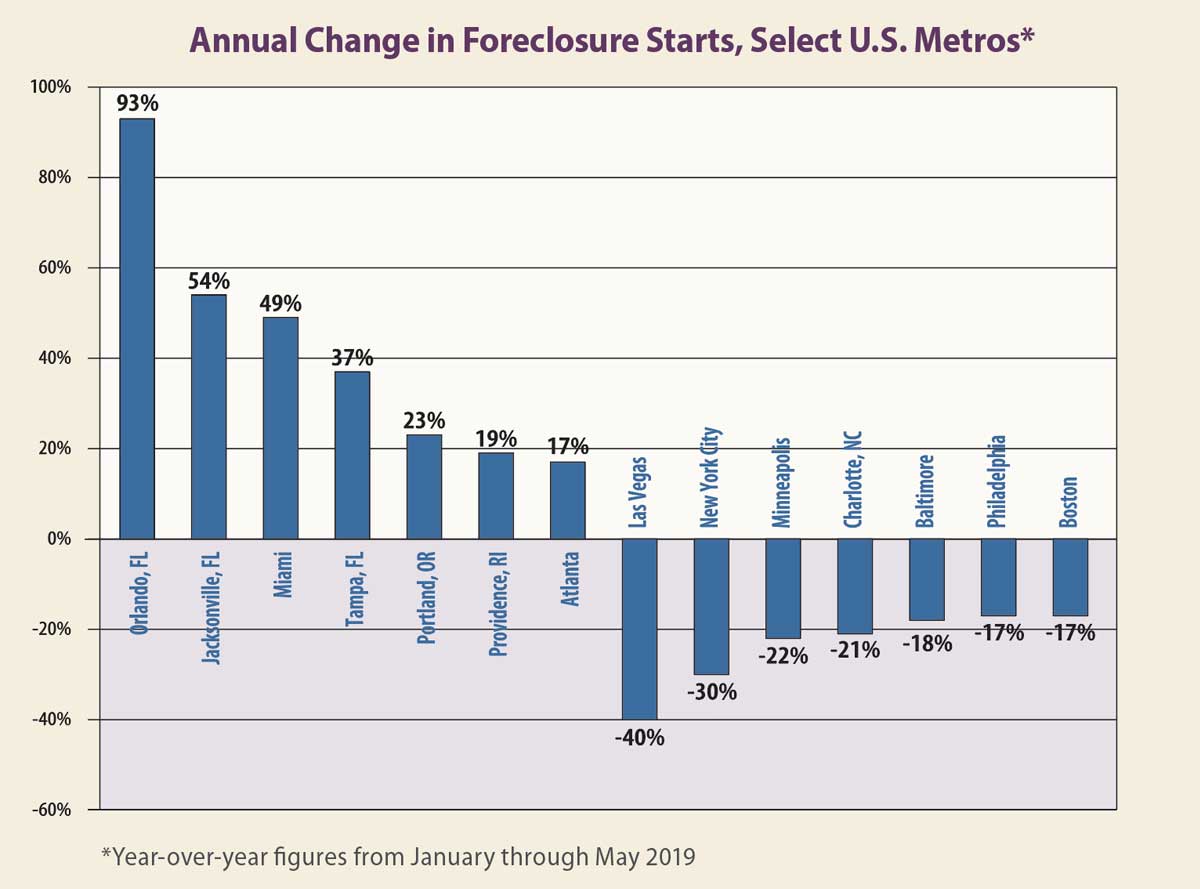Those looking for housing-market risk in the same places it showed up prior to the crash 10 years ago are instead finding a smooth and firm foundation built on relatively conservative behavior by both lenders and borrowers.
This doesn’t mean the housing market is impervious to risk, but risk will most likely manifest itself differently this time around. The nascent patterns of risk that are beginning to emerge in this housing cycle more closely resemble a spiderweb of small fissures in the foundation, rather than the more dramatic cracked-slab scenario that played out a decade ago.
Evidence of that emerging risk shows up in foreclosure-start data analyzed by Auction.com. Year to date through this past May, U.S. foreclosure starts were down 8% compared to the same period a year ago. Counter to the national trend, however, foreclosure starts increased in 90 of 219 metro areas analyzed (41%) — including Seattle (up 7%); Columbus, Ohio (up 19%); Houston (up 7%); and San Diego (up 1%).
Each of these four markets represents a fissure of real estate risk emerging in 2019. These fissures are affordability, low downpayments, natural disasters and migration.
Home affordability is a challenge for many areas across the country as 61% of markets were less affordable than their historic averages as of second-quarter 2019, according to Attom Data Solutions. Seattle, however, has been facing that challenge longer than most. In the Seattle-area counties of King and Pierce, affordability has been worse than its historic average in nine of the past 10 quarters, about twice as long as the U.S. as a whole.
Average wage earners in those counties need to spend more than half of their income to buy a median-priced home, compared to an average mortgage-to-income ratio of 33.9% nationwide. And foreclosure starts in Seattle increased year over year in four of the first five months of 2019.
Foreclosure starts in Columbus, Ohio, also were up annually in four of the first five months of this year, but affordability is unlikely to be the primary cause. Average wage earners need to spend only 27% of their income to buy a median-priced house in Franklin County, the area’s most populous county, according to Attom Data solutions.
The risk fissure in Columbus is more likely related to low-downpayment loans backed by government agencies such as the Federal Housing Administration, U.S. Department of Veterans Affairs and U.S. Department of Agriculture. Auction.com data shows an 83% year-over-year increase in the number of Franklin County properties secured by these types of loans that were brought to foreclosure auction during the first five months of 2019. Meanwhile, properties that were not secured by these types of low-downpayment loans saw a 10% annual decrease in foreclosures during the same period.
Low-downpayment loans may be part of the risk fissure in Houston’s Harris County. The number of homes brought to auction in the first five months of 2019 was up 145% compared to a year earlier, but an even bigger foreclosure surge followed the devastation of Hurricane Harvey in 2017.
Foreclosure starts plummeted immediately following the hurricane as lenders imposed foreclosure moratoriums, but starting in April 2018, foreclosure starts increased on a year-over-year basis for 13 consecutive months, including a 416% jump in November 2018. Foreclosure starts declined 65% annually this past May, an indication that the foreclosure surge triggered by Harvey is now subsiding.
Risk of a more man-made variety is emerging in California. In San Diego County, there was a slight decrease in net migration in 2018, meaning there were more people who moved out of the county than into it, according to the U.S. Census Bureau.
This means weaker demand from homebuyers and that is translating into weaker home-price appreciation — which was down to a new post-recovery low of 2.2% in first-quarter 2019. And there was an accompanying uptick in foreclosure starts in San Diego, as these increased by 1% annually during the first five months of this year.
Author
-

Daren Blomquist is vice president of market economics at Auction.com. In this role, Blomquist analyzes and forecasts complex macroeconomic and microeconomic data trends to provide value to both buyers and sellers using the platform. Blomquist has been cited by thousands of media outlets nationwide, including major news networks, The Wall Street Journal, The New York Times and USA Today. Prior to Auction.com, Blomquist worked at Attom Data Solutions.




